The 30-Second Review
The best laser printer should print quickly while maintaining precise text and simple graphics. It should be easy to maintain and work efficiently without a lot of bells and whistles. To find the best, we spoke to IT experts, scoured consumer reviews, investigated specs, and gathered the top laser printers from reliable brands. We then ran them through a gamut of print quality and usability testing and compared their results with a magnifying glass.
Best Black-and-White
Clear text and sharp lines, plus a minimal design that makes it easy to use.
Best Color
Vibrant colors and quality text with a helpful touch screen.
The Best Laser Printer
- HP LaserJet Pro M203dw PrinterBest Black-and-White Laser Printer
- HP Color LaserJet Pro M252dwBest Color Laser Printer
If you have a home office or small business, a slow printer can be a deep source of aggravation. However, the slow speed may be due to the type of printer you have. Inkjet printers are a common and cheap option but for those who need to frequently print long documents, an efficient laser printer is the way to go.
The HP LaserJet Pro M203dw Printer is our pick for the best black and white laser printer because it excels at printing crisp text and sharp lines for graphs and charts. Pretty simple. Outside of wireless connectivity, the printer doesn’t offer any features, but we don’t mind, because using the printer and replacing toner or paper is painless. It’s more expensive than others on the market, coming in at $200, but If you want to quickly print documents with consistent high quality, the HP M203dw is a solid bet.
Our pick for best color laser printer is the HP Color LaserJet Pro M252dw. This printer surprised us with its ability to produce vibrant colors, and even high-resolution images, accurately. The color is a bit dark, but with sharp text and clean lines the HP Color LaserJet Pro M252dw outperformed all the other color printers we tested. At $300, it’s not cheap, and it will require additional color toner cartridges. But its crisp results and features like an intuitive touch screen for checking toner levels or calibrating the printer make the HP M252dw a great pick for daily printing needs.
The Dell E310dw is great for those who want a cheap printer and don’t require perfect prints. At just $80, the Dell E310dw is the cheapest out of all the printers we tested and still prints crisp text without any problems. But for those who need straight lines for their graphs or charts, the Dell isn’t the best choice. It also has a small 32MB memory, which means that documents over 30 pages may need to be printed in two sessions. Even so, it’s a great budget printer for text-based documents.
For those who prioritize precise colors above all else, the Canon Color imageCLASS LBP612Cdw produced the most accurate color tones. However, in terms of text and lines the printer was outclassed by the HP M252dw. Curved lines with the Canon were jagged and text wasn’t as detailed. In addition, navigating the Canon’s menu is a bit more difficult because the menu screen is smaller. But, if you print a lot of colored graphics, the $250 Canon LBP612CDW is worth a look.
How We Found the Best Laser Printer
A laser printer is ideal for a home office or small business looking to print up to a few hundred pages a day. People with only occasional printing needs, like movie tickets or their annual 1040, are better off with an inkjet as they probably won’t see the high use cost benefits of a laser printer. Laser printers are designed to print long documents much faster than their more common inkjet counterparts. For example, a laser printer can print on average 25 pages per minute compared to the average inkjet printer’s 15 pages. Even better, laser printers use toner. Although toner has a higher initial cost than printer ink, it’s cost effective in the long run because the cartridges last a lot longer — on average they’ll print 2,500 pages vs. an ink cartridge’s 200 pages.
We knew we wanted to provide both a black and white and a color option to meet varying business needs. Color laser printers are more expensive and you’ll also need to buy color toner which will add to maintenance costs. But even starting models have high output and let you add color to simple graphics like a graph or chart. If you simply don’t need color, save yourself some money and go for a black and white. So what’s the best laser printer? The answer comes down to a few key criteria. First, it should be able to produce high-quality documents with precise text and clear graphics. It should also be cost efficient, and setup and maintenance, such as replacing toner and paper, should be quick and painless.
The industry is largely dominated by five big brands: Brother, Canon, Dell, HP, and Samsung. Since specs aren’t always comparable between brands, during our reasearch we compared printers within each brand to find the best quality and price options for a home office or small business. We pored over consumer reviews from retailers like Amazon, Best Buy, and Office Depot, and considered recommendations from sites like CNET and Consumer Reports, to identify printers highly regarded for being reliable and easy to use, and which ones we really ought to miss.
We looked for machines capable of printing enough pages (but not too many).
A laser printer’s output is measured as a duty cycle -- the number of pages it can handle printing every month. We knew we wanted at least 10,000 pages per month (just over 300 pages per day) to be sure to meet the minimal needs of any home office or small business. Some laser printers can have duty cycles as high as 400,000, but these machines are expensive and excessive if all you need is to print a few finance reports or memos throughout the day. So we decided to limit the duty cycle to no more than 40,000 (approx 1,300 pages per day) to avoid paying for industrial strength capacity we probably don’t need.
Unfortunately, duty cycles aren’t consistent between brands. According to Thomas Craig, an IT expert with 25 years of experience, “there is no standard of specifications between manufacturers -- the duty cycle should only be used when comparing models from the same vendor.” So that’s what we did.
Duty cycles vs. recommended monthly limits
We compared the tech specs that matter: pages per minute and memory.
The barrage of technical specs, like driver type and supported network protocols, can be hard to navigate. Luckily, for the average user, most don’t really matter. We focused on two specs that would actually have an impact on your printing experience — pages per minute and memory.
We made sure all of our printers could print 15+ pages per minute to ensure they had reasonably fast output (at least faster than an inkjet!) We found most laser printers have an output between 20 and 40 pages per minute. The next important spec was memory. A laser printer saves your file to its internal memory and then prints from that new file. So if your printer’s memory is too small, say less than 32MB, it will be unable to store (and therefore print) documents longer than 25 or so pages. Laser printer memory ranges from 32 MB to upwards of 256 MB, but It’s hard to know exactly how memory size tracks to document length as it depends a lot on how graphic-heavy your document is. If you only plan on printing shorter documents, you should be fine with 32MB, but if you regularly print lengthy documents, you should be looking in the 128MB range or above. (Both of our top picks come with a whopping 256MB, so they’ll definitely be able to handle that epic quarterly business report.)
We brought in 10 finalists to compare setup and usability.
We ended up with 10 final contenders, a black and white and color option from each of the big five brands, that promised the best printing experience. We brought them all in, and with paper at the ready, we put our new printers to the test.
What we tested
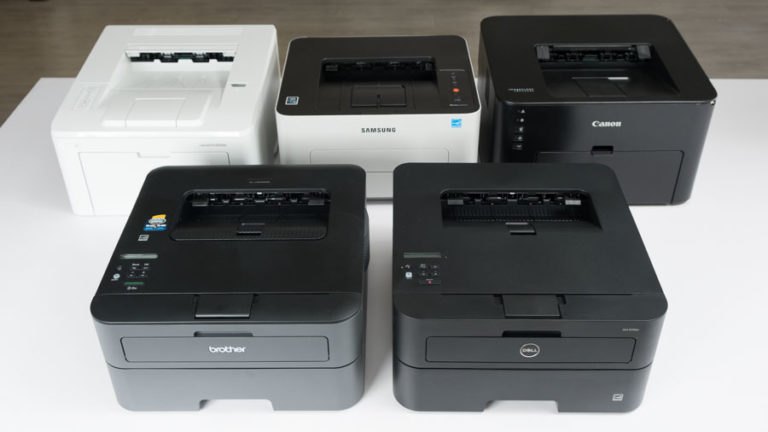
Our black-and-white laser printer finalists from left to right: (Front) Brother HL-L2340DW and Dell E310dw. (Back) HP LaserJet Pro M203dw, Samsung B&W Laser Xpress M2835DW, and Canon imageCLASS LBP151dw.
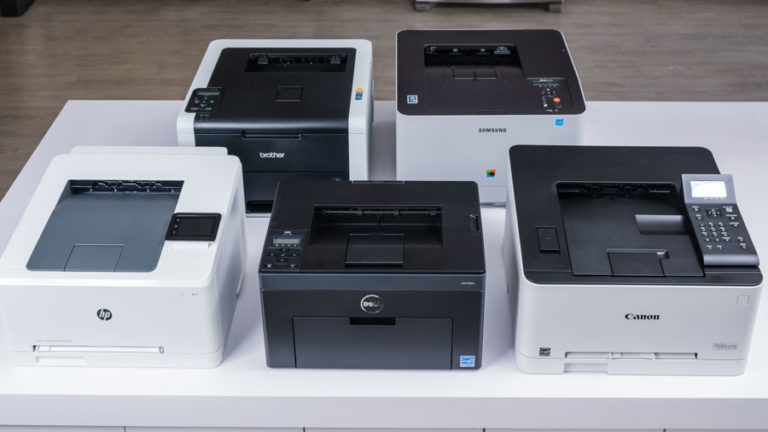
Our color laser printer finalists from left to right: (Front) Canon imageCLASS LBP151dw, Dell C1760NW, and Canon Color imageCLASS LBP612Cdw. (Back) Brother HL-3170CDW and Samsung Color Laser Xpress C1810W.
Setup
We opened our laptops and started installing. We gave bonus points to printers with clear instructions and a quick installation process. Some contenders, like the Canon LBP151dw, had vague infographic instructions that confused us. Our top pick, the HP LaserJet Pro M203dw, took a comparatively long time to install — about 15 minutes — but aside from some desk-tapping, the process was straightforward and painless.
We opened our laptops and started installing. We gave bonus points to printers with clear instructions and a quick installation process. Some contenders, like the Canon LBP151dw, had vague infographic instructions that confused us. Our top pick, the HP LaserJet Pro M203dw, took a comparatively long time to install — about 15 minutes — but aside from some desk-tapping, the process was straightforward and painless.
Usability and Features
We loaded and reloaded each printer with paper and replaced toner cartridges to see if any printers were easier to maintain. None of our contenders were particularly difficult, but we appreciated the designs of some over others. For example, the HP LaserJet Pro M203dw has streamlined toner cartridges and drums that are less bulky which makes them easier to handle and slide into place. On the other hand, the Dell | E310dw’s toner isn’t hard to replace, but its bulky design makes it harder to handle.
We loaded and reloaded each printer with paper and replaced toner cartridges to see if any printers were easier to maintain. None of our contenders were particularly difficult, but we appreciated the designs of some over others. For example, the HP LaserJet Pro M203dw has streamlined toner cartridges and drums that are less bulky which makes them easier to handle and slide into place. On the other hand, the Dell | E310dw’s toner isn’t hard to replace, but its bulky design makes it harder to handle.
We also looked for any features that improved our experience (and found some that really didn’t). The Dell 5310dw offers two-sided (duplex) printing, but requires you to manually reinsert the paper in order to print on the other side, which we could do with regular printing. The Samsung B&W Laser Xpress M2835DW’s paper tray extends about an inch past the back of the printer, making for awkward placement, and requires you to either pull the tray all the way out, or reach around the back, to adjust for different paper sizes.
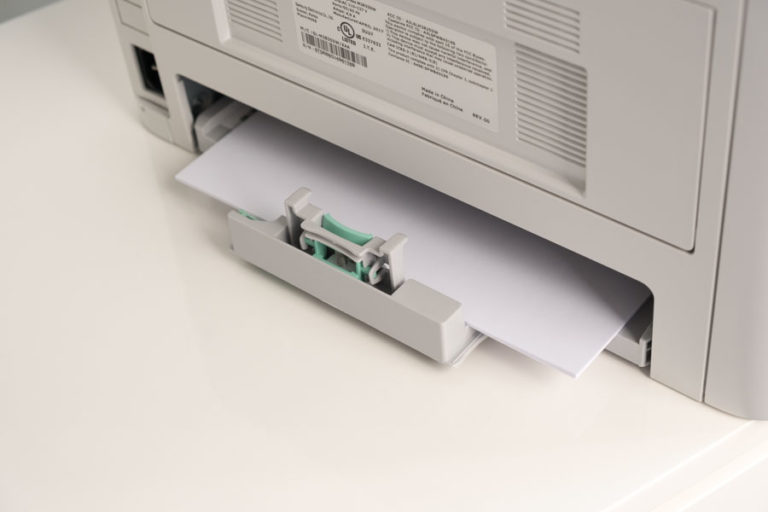
The Samsung B&W Laser Xpress M2835DW's poorly designed paper tray juts out when storing standard letter-size paper.
All of our contenders offer Wi-Fi connectivity and some offer ethernet connectivity for wireless printing, but these extra features often require unnecessary software that can slow down your computer. Fernando Leon, Vice President of Sales for IT company Single Point of Contact, told us “You want to steer clear of huge installations that offer multiple software applications to install. Making your printer available on the web [and] printing wirelessly from your phone are all examples of things you want to avoid.” We kept our testing to USB connections in order to see which printer performed best under optimal conditions, and turned to consumer reviews to check our contenders’ reputations for wireless printing.
We designed test sheets and scored our printers on their quality.
We’ll be upfront. All of our printers were able to print long documents quickly. Instead of focusing on negligible time differences of a few seconds, we shifted our attention to the quality of the documents.
Harmon told us, “Laser printers are designed for people who need to produce a lot of documentation but with not amazing print quality.” While we agree that speed is the priority for laser printers, you shouldn’t have to sacrifice quality. Laser printers are an investment and jagged text and blurry graphs are a disappointing return. We created two test sheets: for both types of printers, a black and white sheet with different fonts, text sizes, and lines, and for the color printers, an extra color sheet with various hues, color swatches, and colored lines. We wanted to see which printers would produce clear text and precise simple graphics.
Black-and-White Tests (black-and-white and color laser printers)
Text
We tested each printer’s ability to print standard paragraphs and sentences from 2 pt. up to 18 pt. font. Seeing how a printer handles text, especially white-on-black, will show how precise your printer is. Most contenders were able to print clear and legible text, but a closer look showed the Samsung M2835dw produced slightly jagged curved letters. Not a dealbreaker, but not the precision we saw from both HP printers.
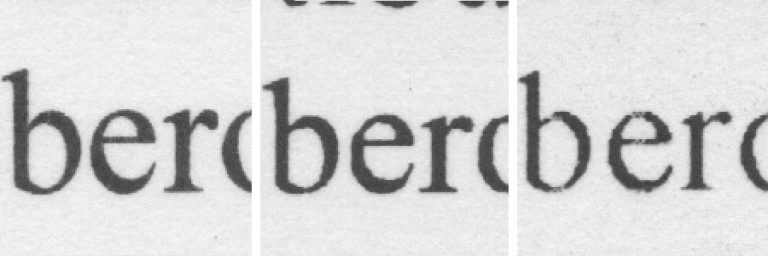
The HP LaserJet Pro M203dw (left) produced smooth, crisp text that others, like the Samsung M2835dw (center) and Canon imageCLASS LBP151dw (right), couldn't match.
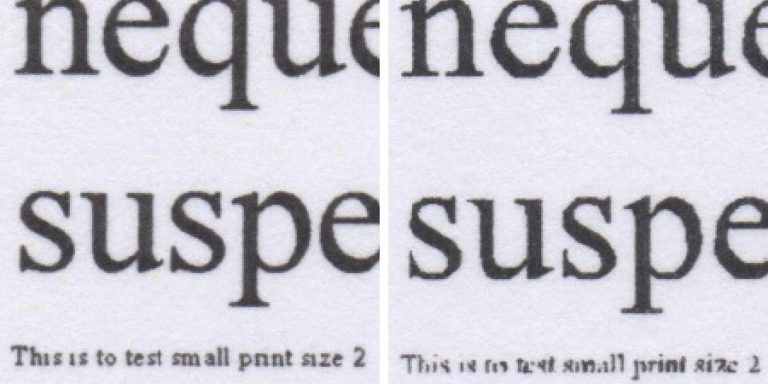
The HP Color LaserJet Pro M252dw (left) produced finer text details than competitors like the Samsung C1810W (right).
Simple graphics and shades
A laser printer should be able to handle simple graphs, tables, and charts, although it definitely isn’t designed to print complex graphics. We used images, like a graph with black and grey lines, to see how accurate our printers were and how well they could handle lighter shades. The HPs both topped their categories again in this test, while the Brother HL-2340DW struggled with producing crisp lines on the graph, despite its clear and precise text.
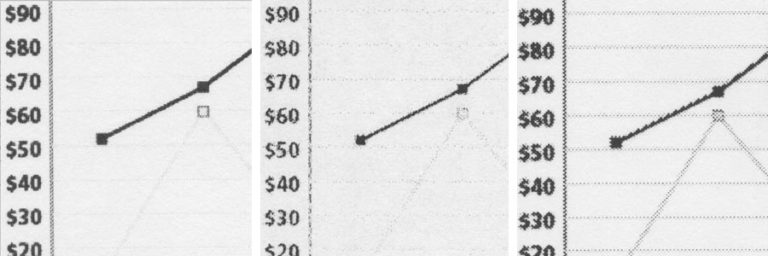
HP's LaserJet Pro M203dw (left) produced the best lines, while the Canon imageClass LBP151dw (center) handled shades well. Brother's HL-2340DW (right) printed jagged diagonal lines.
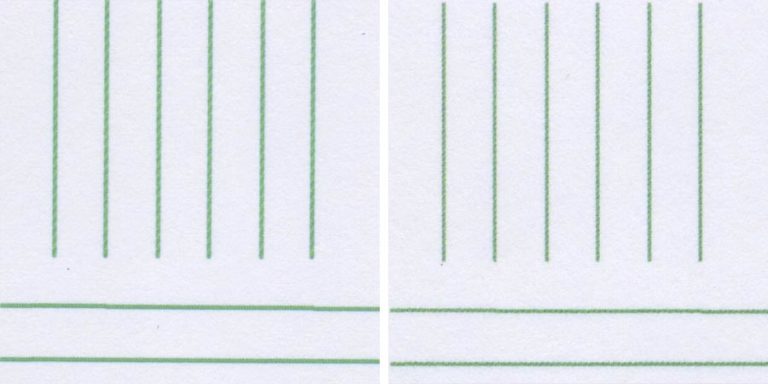
The HP Color LaserJet Pro M252dw printed solid, crisp lines, while the Brother HL-3170dw's output was noticeably thinner and less consistent.
Color Tests (color printers only)
Granger Rainbow
Granger rainbows are a tool for testing the hue, saturation, and brightness of color output. A good printer will have smooth transitions between colors with minimal imperfections. All of our color printers had trouble with lighter colors, but differences in overall quality were noticeable. The HP Color Laserjet Pro M252dw had smoother transitions than others, like the Brother HL-3170dw which had trouble separating yellow and green.
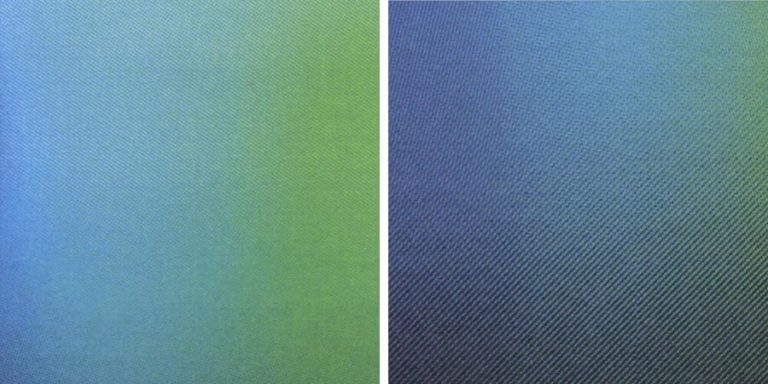
The Canon imageCLASS LBP612CDW's smooth gradients (left) outclassed models like the Brother HL-3170CDW (right).
Radial Lines
Most printers struggle with radial lines, but they’re a good indication of printing precision. The less jagged the lines, the more precise the printer. The green ink adds the challenge of mixing colors. The HP M252dw had the smoothest curves but none of our printers could reproduce the bright green color from our digital file and some, like the Canon LBP612CDW, couldn’t handle the curves.
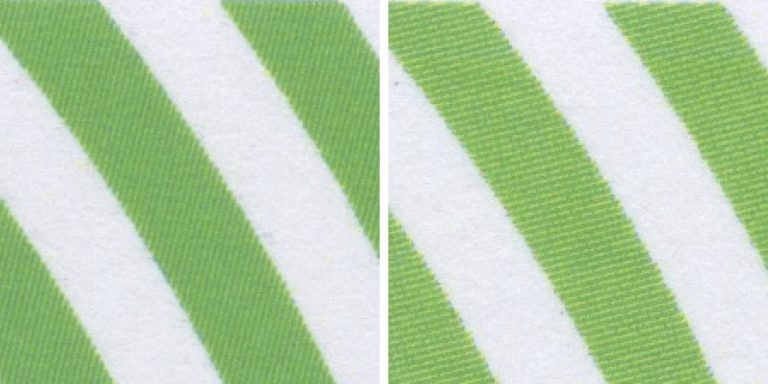
The HP Color LaserJet Pro M252dw printed the smoothest lines, with the Brother HL-3170CDW faring worse.
Vibrancy, Saturation and Resolution
Laser printers aren’t designed to handle high-resolution photos, but we wanted to see if any handled it better than others in case you need an image in a pinch. On low-quality printers, images will appear faded instead of crisp. The Canon LBP612CDW and HP Color Laserjet Pro M252dw impressed us with their deep color, while the Brother HL-3170dw lacked vibrancy.

Color laser printers aren't really meant for photo prints, but the Canon imageCLASS LBP612CDW (left) did better than others, like the Brother HL-3170dw (right).
Color-Matching Swatches
We used Pantone swatches and CMYK process colors to see how well the printers could mix cyan, magenta, yellow, and black toner. We compared our swatches to a Pantone Uncoated CMYK Guide Book. Full disclosure: none of the printers were great at it, but some were less okay than others. The Samsung C1810W made colors a bit too dark, while the Canon LBP612CDW was the most accurate.
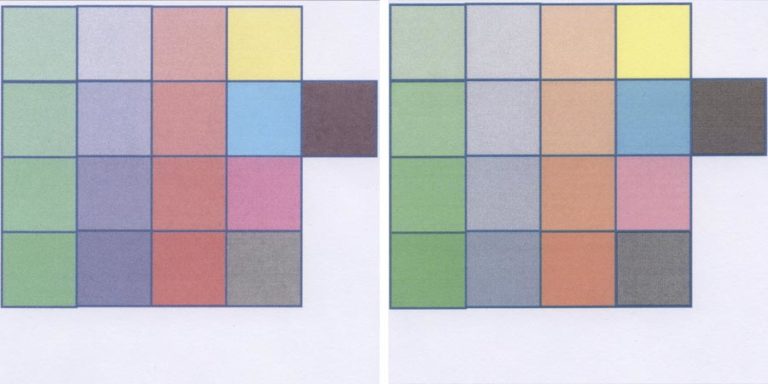
The Canon imageCLASS LBP612CDW (left) printed the most accurate color swatches, while Samsung's C1810W (right) prints were a little darker than we wanted.
In our quality tests, some printers performed well with certain tasks but struggled with others. Some consistently outperformed others enough to narrow our list down to the top three performers for each category.
Top Black and White Printers
- Dell E310dw
- HP LaserJet Pro M203dw
- Samsung B&W Laser Xpress M2835DW
Top Color Printers
- Canon Color imageCLASS LBP612Cdw
- Dell C1760NW Color
- HP Color LaserJet Pro M252dw
Documentation Testing
With our top 3 performers in each category, we tested each printer’s ability to print long documents. Our goal was to see if any printers were better at maintaining consistent printing speed and quality across at least 20 pages. In the end, finding the best came down to fine details. But even with small quality differences, we were able to identify two printers that were better than the rest.
Our Picks for Best Laser Printer
Best Black and White Laser Printer
HP LaserJet Pro M203dw PrinterA minimal printer that does its job and does it well
We’ll admit that we were surprised to see HP take both of our top spots. While the brand receives recognition for its reliability, we always approach highly-marketed brands with a bit of skepticism. Simply put, it took our top spot for black and white laser printer because it was straightforward to use and produced the most precise text and lines.
The HP M203dw simply excels at printing. It was one of only two printers that didn’t lose any detail with serif font — fonts like Times New Roman with small decorative lines attached to letters. The Dell E310dw was the only other printer that managed to print serif fonts accurately but it struggled to produce straight lines like the HP.

The HP M203dw (left) handled text well and produced smoother curves than the Brother HL-2340dw (right).
For those who need to print graphics with straight lines for their documents, the HP M203dw is hands down the best. In both the line graph and radial line tests, it was able to produce the straightest and least pixelated lines. The HP M203dw’s light grey lines were a little hard to see, but they were still straight, and we appreciated the accuracy of the darker text and graphics. After all, consistent and clear text will make up the majority of professional documents.
On the topic of consistency, the HP M203dw excelled at maintaining its print quality in our long document test. Our 30-page document came out clearly and quickly. The closest competitor in terms of overall quality, the Dell E310dw, also managed consistently clear text but it wasn’t better. Our experts nudged us over the line toward HP. According to Leon, “HP is a brand of printer that has been well known for quality and reliability,” and Harmon told us “from experience, stick with the HP” because other brands, Brother in particular, usually cause more problems for his clients.
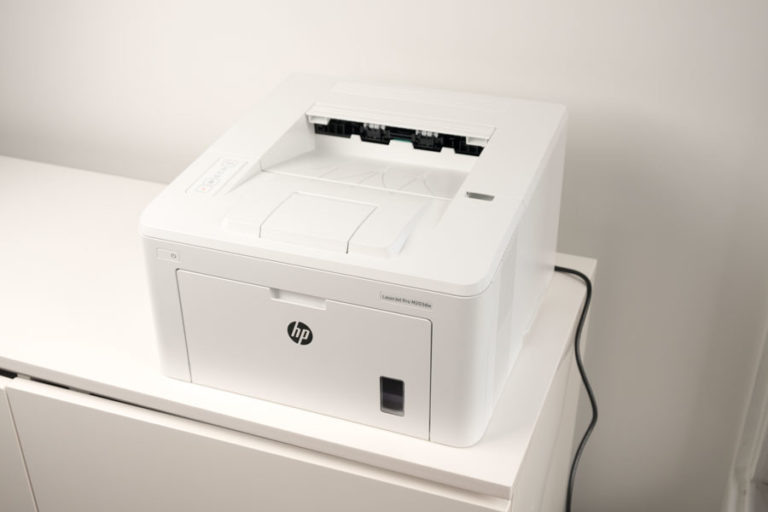
Setting up the HP Laserjet Pro M203dw is easy, although it did take 15 minutes. Maintaining the printer is equally effortless. Unlike other printers, there’s a toner symbol that indicates where you can open the printer to replace toner. We also liked the clear window on the paper tray door that let us see the paper levels -- a smart design choice that enables us to check the paper level before printing. Not all paper trays are as easy to refill as the HP M203dw’s either, but it isn’t perfect. The single-sheet tray for single-prints is located further inside the paper tray door, and we had to physically bend over, as if reaching under our desk, in order to feed smaller media like envelopes into it. Not a dealbreaker, but kind of annoying. Laser printers aren’t designed for single-sheet printing, though, so this flaw is a minor one.
The HP M203dw has a respectable 30,000 duty cycle, 256 MB of memory, which means you’ll be able to print longer documents without having to perform multiple prints, and wireless connectivity. The control panel is simple, with just a few indicators, such as attention lights for printer errors and low toner. We’ll admit, we were originally disappointed by this absence of features and controls but we were proven pleasantly wrong. The HP M203dw is designed to do one thing: print. And it does it well. We can imagine it fitting seamlessly into the workflow of a busy home office or small business without requiring technical finesse.
In terms of cost projection over 3+ years of ownership, the HP M203dw starts at $200 which makes it our most expensive option for black and white laser printers. Its toner is a bit pricier than that of its competitors, too. A basic toner cartridge costs $64 compared to the Brother HL-L2340DW’s $45 cartridge. But then, the HP M203dw cartridge contains more toner and will give you 400 more pages than the Brother cartridge before it needs replacing. We recommend going with the high yield cartridgesthat cost $90 and hold twice the amount of toner as a basic cartridge. The HP M203dw also follows standard practice by arriving with a starter cartridge.
Best Color Laser Printer
HP Color LaserJet Pro M252dwAn exceptional color option that comes with a touch screen
Laser printers are known for having lower-quality images, so we were impressed by the depth of color and vibrancy that the HP M252dw produced. Out of all the printers we tested, the HP M252dw was able to print the most precise text and colorful images without fuzz. Better still, it offers intuitive features that actually boost usability.
Text with the HP M252dw was crisp and consistent. We’d even go so far as to say that the HP M252dw printed better black text and lines than any printer we tested, including the black and whites. Other color laser printers didn’t come close. The Samsung Color Laser Xpress C1810W performed well with our line graph, but had a few jagged letters. The Canon LBP612Cdw and Dell C1760NW did well with text, but couldn’t accurately reproduce lighter shades like the HP.
The HP’s ability to avoid any fuzz or distortion extended to the green radial and straight lines we used to test precision and color mixing. Again, the HP M252dw had little trouble producing crisp lines with just a few imperfections. The Samsung C1810W produced the straightest and most crisp lines, but there were tints of blue rather than green which indicated poor color mixing. The Canon Color imageCLASS LBP612Cdw did perform better in our color testing. But the HP M252dw took a close second and had better precision overall when printing text and lines.

The HP M252dw (left) did an impressive job with our photo test, where models like the Brother HL-3170dw (right) struggled.
We were surprised to see the HP M252dw reproduce a high resolution photo of colorful fruits and vegetables without it looking dull. While the image and coloring with the HP M252dw is a bit darker than the original image, tomatoes came out in a deep red hue without looking grainy. The closest competitor, the Canon LBP612cdw, had better color accuracy, but a closer look revealed fuzzy white spots in the image.
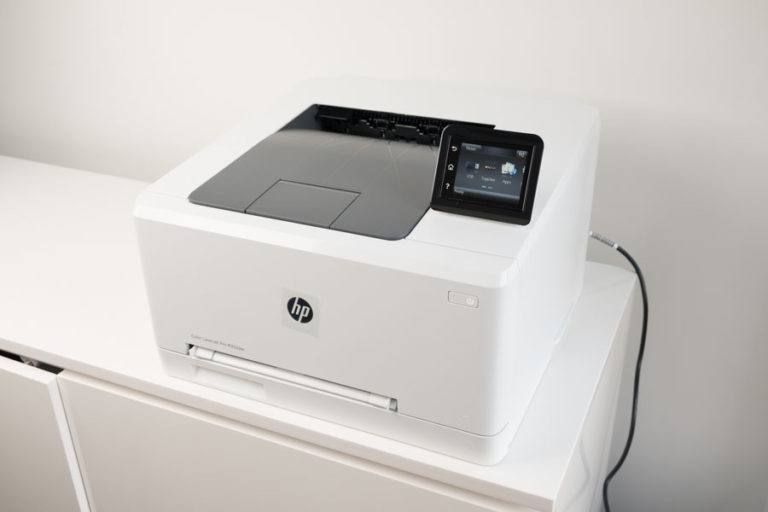
Setup for the HP M252dw was quick and painless, and didn’t require the extra time that its black and white counterpart did. Maintenance such as replacing toner and paper is also straightforward and effortless. The most obvious and most important difference with the HP M252dw is the inclusion of a touch screen. The controls are responsive and all the menu options, such as checking toner levels or calibrating print quality, are easily accessible. The touch screen also displays an animated tutorial that shows you how to insert a blank sheet of paper to clean any lingering toner. It’s a thoughtful touch that actually helped our tester complete the task.
The HP M252dw printer isn’t perfect though. We had trouble fitting the letter tray back inside the printer when reloading the main paper tray. We soon realized there was a trick to putting the letter tray back first. We didn’t have any issues again once we solved this puzzle, but it’s a noticeable and confusing flaw in a machine otherwise designed with users in mind.
In terms of cost, the HP M252dw is $300 which makes it $115 more expensive than its closest competitor in print quality, the Canon LBP612Cdw. Toner costs about $80 for each color cartridge, or you can buy all four for under $300. Just like its black and white counterpart, the HP M252dw offers a 30,000 duty cycle and 256 MB memory, not to mention the best print quality in its category. The HP M252dw is the way to go for color.
Others to Consider
While the Dell E310dw struggles with producing lines for graphics, it does an excellent job producing precise text. Letters have no jagged lines and it was the only other black and white printer that lost no detail with serif fonts. It also maintains this level of quality with longer documents. The best part? It only costs $80.
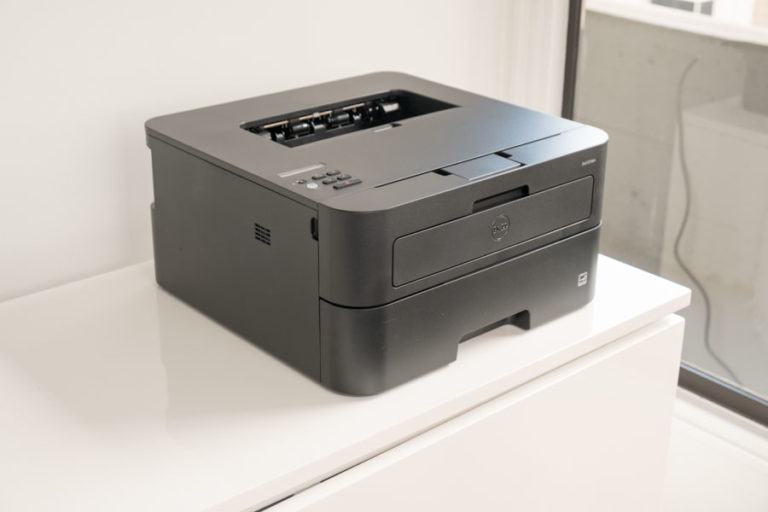
The Dell | E310dw isn’t our top pick, because it isn’t as versatile as the HP M203dw. The lines on graphics are noticeably jagged or pixelated which means tables, graphs, and charts will not look good on paper. It includes more features than the HP M203dw as well, but just isn’t as effective. We followed our experts’ advice and prioritized printers that print the best.
Some may point to the Brother L2340dw as the more popular option for black and white printers, but in our tests we couldn’t find any noticeable differences between these two. In fact, the printers are direct clones of each other and can even hold each other's paper trays. With no discernible difference except for the cheaper price of the Dell, we recommend the Dell 5310dw.
If you are looking for a laser printer with the best color accuracy above all else, the Canon imageCLASS LBP612CDW is our recommendation. Out of all the color printers we tested, the Canon imageCLASS LBP612CDW was the most accurate when reproducing our high-resolution image and pantone color swatches. Unlike the HP Color LaserJet Pro M252dw, colors weren’t too dark. At the same time colors weren’t too faded like the Brother HL-3170dw.
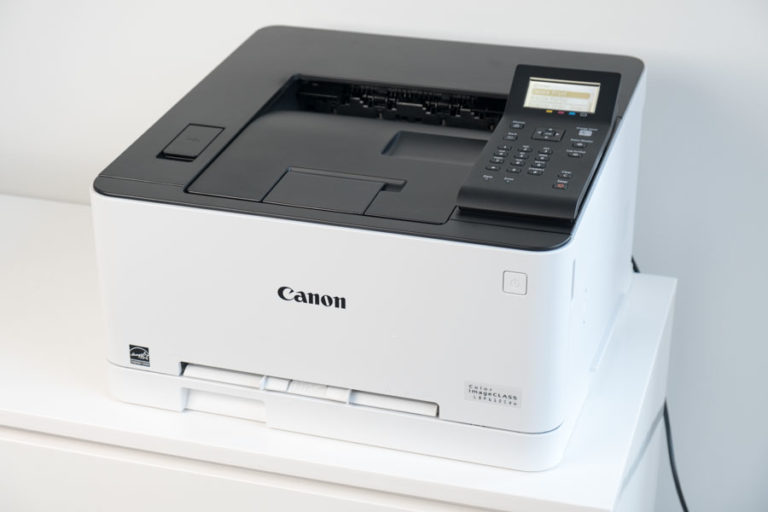
The Canon imageCLASS LBP612CDW isn’t our top pick, because it doesn’t print text or lines as well as the HP Color LaserJet Pro M252dw. Since text and straight lines for charts or graphs are the most important for business documents, the better performance of the HP managed to edge out the victory. In addition, the HP Color LaserJEt Pro M252dw has a more usable touch screen versus the Canon’s control pad that reminds us of an old fax machine.
For those who will specifically be printing a lot of colored text or simple graphics, the Canon is a good choice, but the HP LaserJet Pro M252dw offers comparable color quality and greater versatility.
Did You Know?
Don’t use bargain or knock-off toner.
Toner is expensive but all of our experts warned us against using knock-off or bargain toner. Leon told us that “using brand toner would be highly advisable as recycled toner tends to explode and spread throughout the printer.” While toner can be expensive, buying the correct cartridge from your laser printer’s manufacturer will prevent heartache in the future. Black toner cartridges can cost between $60 and $90, but typically last for 2,000-3,500 pages. Color printers use four CMYK toner cartridges instead of one black cartridge. The cyan, magenta, yellow, and black cartridges (CMYK) can be replaced separately and typically cost around $40-60 each. Our experts recommend buying in bulk to save money and have backups when you need them.
You’ll also need to replace your drum after extended periods of time. The lifespan of a printer drum depends on the manufacturer. Starting models have drums that last for around 12,000 pages. A good indicator of a worn out drum is if your print quality suddenly drops.
A lot of technical problems have easy fixes.
There’s nothing more annoying than a printer with technical problems. But before you take your printer out back, Office Space style, there are a few ways to fix common problems without heading to a repair shop. Harmon stated that the leading reason for technical problems is either due to inappropriately placed toner or paper. He told us “if you make the mistake of using the wrong paper, it can cause problems [and] gray lines running through your document could mean that you placed the toner wrong.” His advice is to make sure your paper and toner are placed correctly.
In addition, he recommends checking to see if you have selected the right paper settings for the printer. For example, if you want to print an envelope but have the settings set to plain paper, you’ll run into problems. Printers can’t automatically adjust to paper type, so you’ll need to switch settings if you switch paper style. When the printer prompt comes up on your screen, there will be options for choosing the right style of paper.
Pick a nice, clean spot for your printer.
We learned from Craig that the biggest favor you can do for your printer is “ensure that the environment is kept clean and dry because this will eliminate small particles from accumulating in the machine and keep dust from entering when the covers are opened.” In addition, he explained that the location of printer paper can have an effect too. “Paper that is sitting out will accumulate dust that will be distributed into the printer, and paper may have absorbed moisture causing it to stick together which can lead to a paper jam.” Luckily the solution is simple. Keep your printer paper in a box or drawer and gently fan it to shake off any dust before placing it in the printer.


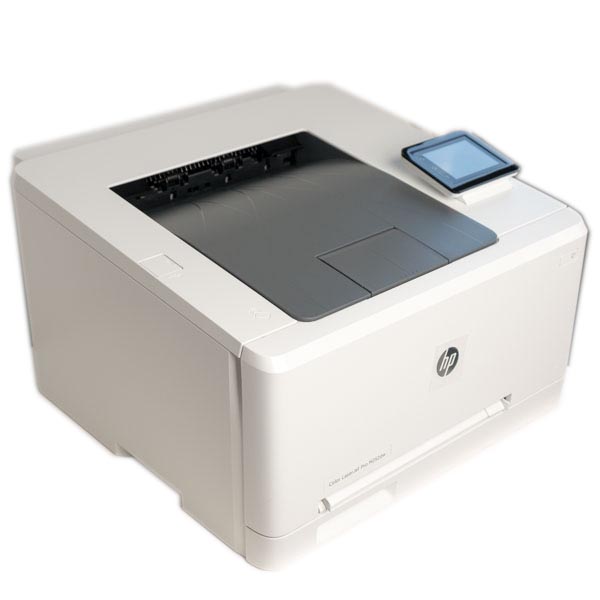



No comments:
Post a Comment